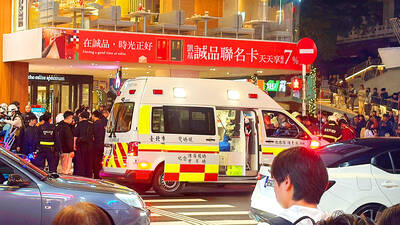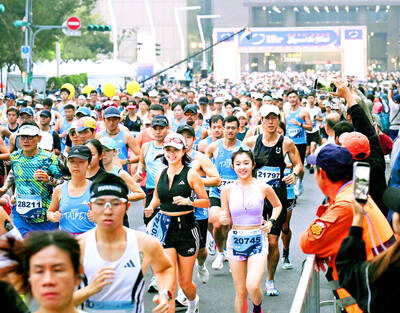Taiwan is to play a critical role in NASA’s Resource Prospector mission, which aims to be the first mining expedition on the moon in the early 2020s, and is expected to use a Taiwanese-made lunar lander to excavate water, oxygen and hydrogen.
The Chungshan Institute of Science and Technology is to build an uncrewed lunar lander to carry a rover to polar regions of the moon to mine resources, particularly subsurface water, international program director Han Kuo-chang (韓國璋) said.
The project is the first time Taiwan has participated in a NASA moon mission and it is hoped it will boost the nation’s visibility in the international aerospace industry.
“Taiwan has an outstanding ability to build electronic components and auxiliary systems for spacecraft, but the nation has had little opportunity to participate in space missions, so it has limited space flight history. The participation in NASA’s Resource Prospector mission might earn Taiwan a ticket into the aerospace industry supply chain,” Han said.
The institute is to deliver a lunar lander on a budget of about NT$1.5 billion (US$46.84 million).
It has to select and test commercially available parts that can function in space, where they would be exposed to extreme heat and radiation, Han said.
“It will be Taiwan’s first moon landing mission, and challenges involved in building a lunar lander include analyzing the orbit, controlling lander posture and velocity and landing the vehicle in the desired location where there is no air resistance and little atmospheric pressure. All those are very difficult,” he said.
However, the Resource Prospector mission is not the first time that the institute has worked on a NASA project.
It built the 1 tonne Alpha Magnetic Spectrometer for the International Space Station, which measures antimatter in cosmic rays and searches for evidence of dark matter.
The spectrometer has functioned uninterruptedly since 2011 in an environment where equipment can easily malfunction due to high daily temperature differentials and high-energy cosmic rays.
“The institute’s space computer is one of the most reliable NASA has ever had, which is why NASA chose to collaborate with Taiwan instead of South Korea in the moon-mining mission,” Han said.
The mission is aimed at reducing the cost of deep-space exploration by harvesting the basic building blocks of life and fuel, and generating the components in space.
NASA began exploring whether there was water on the moon in the 1990s and space missions have since proven its existence.
The Resource Prospector mission is to determine if the water can be extracted, Han said.
The rover is to explore polar regions of the moon and areas where sunlight does not reach, because it is believed that is where sub-surface water is most likely to be found.
The moon lander is expected to be completed by 2018 and the mission is expected to be launched in the early 2020s — if it is given the green light.

TRAGEDY STRIKES TAIPEI: The suspect died after falling off a building after he threw smoke grenades into Taipei Main Station and went on a killing spree in Zhongshan A 27-year-old suspect allegedly threw smoke grenades in Taipei Main Station and then proceeded to Zhongshan MRT Station in a random killing spree that resulted in the death of the suspect and two other civilians, and seven injured, including one in critical condition, as of press time last night. The suspect, identified as a man surnamed Chang Wen (張文), allegedly began the attack at Taipei Main Station, the Taipei Fire Department said, adding that it received a report at 5:24pm that smoke grenades had been thrown in the station. One man in his 50s was rushed to hospital after a cardiac arrest

A car bomb killed a senior Russian general in southern Moscow yesterday morning, the latest high-profile army figure to be blown up in a blast that came just hours after Russian and Ukrainian delegates held separate talks in Miami on a plan to end the war. Kyiv has not commented on the incident, but Russian investigators said they were probing whether the blast was “linked” to “Ukrainian special forces.” The attack was similar to other assassinations of generals and pro-war figures that have either been claimed, or are widely believed to have been orchestrated, by Ukraine. Russian Lieutenant General Fanil Sarvarov, 56, head

SAFETY FIRST: Double the number of police were deployed at the Taipei Marathon, while other cities released plans to bolster public event safety Authorities across Taiwan have stepped up security measures ahead of Christmas and New Year events, following a knife and smoke bomb attack in Taipei on Friday that left four people dead and 11 injured. In a bid to prevent potential copycat incidents, police deployments have been expanded for large gatherings, transport hubs, and other crowded public spaces, according to official statements from police and city authorities. Taipei Mayor Chiang Wan-an (蔣萬安) said the city has “comprehensively raised security readiness” in crowded areas, increased police deployments with armed officers, and intensified patrols during weekends and nighttime hours. For large-scale events, security checkpoints and explosives

PUBLIC SAFETY: The premier said that security would be tightened in transport hubs, while President Lai commended the public for their bravery The government is to deploy more police, including rapid response units, in crowded public areas to ensure a swift response to any threats, President William Lai (賴清德) said yesterday after a knife attack killed three people and injured 11 in Taipei the previous day. Lai made the remarks following a briefing by the National Police Agency on the progress of the investigation, saying that the attack underscored the importance of cooperation in public security between the central and local governments. The attack unfolded in the early evening on Friday around Taipei Main Station’s M7 exit and later near the Taipei MRT’s Zhongshan